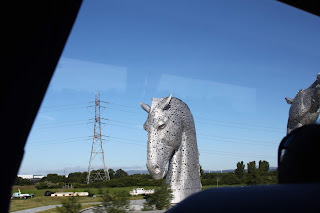The National Museum of Computing
http://www.tnmoc.org/
&
Bletchley Park
https://bletchleypark.org.uk/
"The National Museum of Computing, located on Bletchley Park, is an independent charity housing the world's largest collection of functional historic computers, including the rebuilt Colossus, the world’s first electronic computer, and the WITCH, the world's oldest working digital computer. The museum enables visitors to follow the development of computing from the ultra-secret pioneering efforts of the 1940s through the large systems and mainframes of the 1950s, 60s and 70s, and the rise of personal computing in the 1980s and beyond."
"About Us" ,National Computer Museum website. Link above.
Sheridan Williams, Mathematician and National Computer Museum employee led the LIS group on an in-depth tour about the history of computing. We began with Bletchley Park's involvement in breaking the encrypted German code from WWII. Sheridan asked if we were familiar with the movie The Imitation Game starring Benedict Cumberbatch as Alan Turing. He jokingly said the movie should be called The Irritation Game due to inaccuracies in the story. The movie focuses on Alan Turing and the group formed to break the German code. Only one woman is prominently featured in the movie, an analyst played by Keira Knightley. If one were to visit Bletchley Park at the time, he/she would have found a total of 10,000 employees. The movie failed to point out that 8,000 of these employees were women. Women outnumbered men by a ratio of 8 to 1.
 |
| Actual Lorenz machine used by the Germans to encrypt messages. |
 |
| The Colossus Computer, considered to be the first electronic computer, designed by Tommy Flowers to analyze German messages generated by the Lorenz cipher. |
 |
| Colossus Computer |
As a librarian and graduate student, I certainly appreciate and utilize computers in my everyday life. Once the tour was over, Sheridan was asked about the NMC archive and digitization of the collection. Unfortunately, I was not part of the group who were able to see the archive. The tour provided great detail about the history of computing, however I wish that more information about direct applications to the field of library science, or how the NMC collection is cataloged, digitized and managed, could have been shared with the entire LIS group.
Following the NMC tour, LIS explored Bletchley Park on our own. I loved the multi-media and interactive displays allowing us to take a more active role in learning about the history and people of Bletchley Park. I watched a movie describing what was expected of female code breakers and the training they underwent. I put on headphones and scanned to intercept a radio signal over the airways. I learned about the difference between a code and a cipher (see photo below) and perused books, posters and letters from that era. The 40's music playing in the gift shop also helped transport me back to the WWII era. One gentleman visitor in a wheelchair was happily singing along to the music he enjoyed in his younger days. That is a visual that will stay with me.
 |
| Enigma machine. (One is also on display at the British Library.) |
 |
| Letter written by US President Dwight Eisenhower to Major General Sir Stewart Menzies expressing his thanks and appreciation to the men and women of Bletchley Park. |



















































































































































































































































